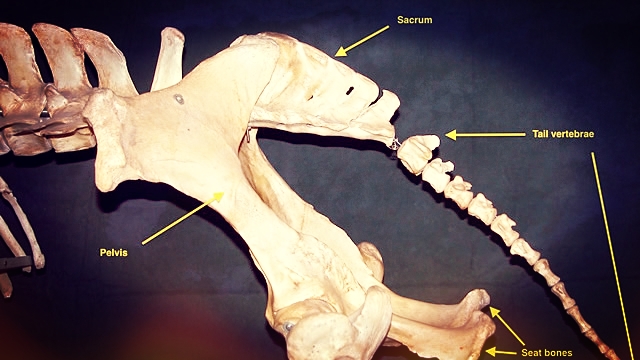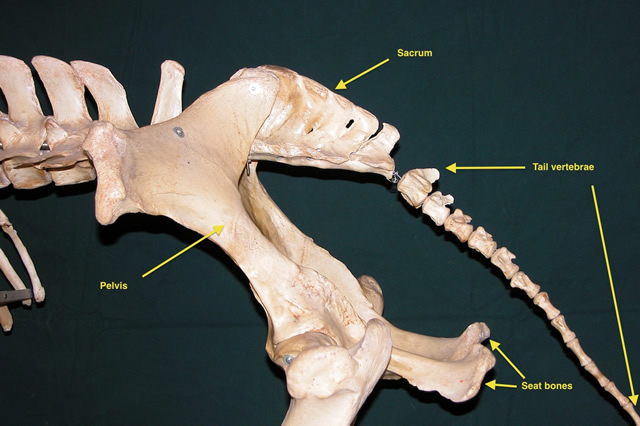Have you ever watched your horse standing in the field gently swishing the flies away with his tail? Have you ever been the recipient of one of those tail swishes? It’s amazing how it can sting when the tail hair lashes across your face. You might even have thought on occasion it would be great if you had a tail to keep the bugs out of your face too.
The horse’s tail is not only one of the more beautiful features of most horses it also is very functional. The horse’s tail is expressive and can be used to indicate displeasure or discomfort by swishing or wringing movements. If you have a dominant mare in the barn watch how she uses her tail to tell others to stay away. Sometimes just a little lift of the tail will be all that is necessary move another horse from the hay.
The tail also protects the horse’s elimination and reproductive structures against the environment. Next time there is a rainstorm watch how the horses in the field will put their hindquarters to the wind. They tuck their tail snuggly between their buttocks.
The tail can also indicate how soft the horse is in his back when you are riding. A rhythmic side-to-side swing indicates the horse is relaxed. A stiff or uneven movement can indicate stiffness in the back.
The horse also uses the tail for balance. I have heard it said around the racetrack that when a horse is running, if his tail drops, he is finished meaning he has no more run in him. In jumping the horse can also use the tail for balance. Perhaps you might remember the movie “The Horse with the Flying Tail? Nautical would flag his tail in the air over every jump.
The horse’s tail is made up of 16 – 20 vertebrae (spine bones), muscles and ligaments, which explain why it is so maneuverable. By contrast our tail is made up of four or five small vertebrae, which are fused together and referred to as the coccyx. You will find your coccyx at the bottom most part of your sacrum, the flat triangular bone at the back of your pelvis. If you place one hand on your sacrum and gently run down the middle following the bone you will notice that it curves under. At the end of the curve is your coccyx. It feels a little pointed at the end. Be careful not to push too hard. Most of us never notice our tailbone unless we fall on it – a very painful experience! For riders tailbone injuries can be serious because it is very painful to sit with a broken tailbone.
While we both have a tail of sorts ours is only a rudimentary kind and does not have the ability to swish. While the horse’s tail is beautiful and an expression of their personality as well as assisting them in balance.
Next time you are at the barn take a moment to notice your horse’s tail more thoroughly. The tailbone, the hard part inside the tail, is a continuation of the horse’s spine from the sacrum just like ours. Carefully feel the underside of the tail starting from the top pressing in gently to sense the bone inside that runs all the way down to the tip of the tail. Do be careful! The horse’s tail is extremely powerful and if they are not used to having your hand there they might clamp their tail trapping your hand. Start from the side of the tail if you are unsure and find out if your horse is OK with your fingers on the underside. Most horses love having their tail scratched and groomed once they are used to it.
In horses the number of tail vertebrae can vary from 16 and 20, which might explain why some horses tail are so much longer than others. Between each vertebra is a joint. If you are careful and firm you will be able to gently move each vertebra. Start at the top. Hold the tail with one hand. Take your other hand below the first and move the tail back and forth, side-to-side or a little up and down while keeping the first hand still. Feel how there is movement between your two hands. Slide down a little and do this again, each time holding one vertebra above feeling for the movement below it. See how many vertebras you can identify in your horse. It is easier to feel the vertebrae towards the bottom as there is less covering the tailbone at this point. Notice how the vertebrae go from bigger to smaller as you go down the tail.
Observe if your horse’s tail is flexible all the way down or has a stiff spot. Maybe there is even a kink in the bone. This is not unusual and could indicate that your horse damaged his tail at some point. Take a moment to make small movements with the tail where it is a bit stiff. Working down each joint can often restore full movement. Most horses really enjoy having your play with their tail. Finally, gently pull some tail hair towards the top of the tail alternately side to side. Let your body sway with it and slide down the hair as your pull. This will start an undulation or swing in the horse’s tail. As you continue you will notice that side-to-side swing will travel up the horse’s spine. You may even notice that your horse’s head starts to sway with the rhythm!



